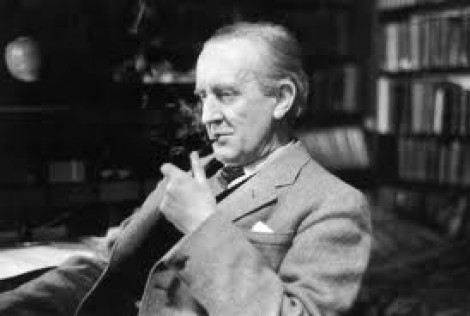TOLKIEN, J.R.R.
“Those were the stories that stayed with you. That meant something, even if you were too small to understand why”
When John Ronald Reuel Tolkien first penned the words “In a hole in the ground there lived a hobbit” he was probably unaware that he had started a love affair between millions of people around the globe and a fantasy world called Middle Earth. When still very young Tolkien had shown a fascination and facility with language, with its structure and beauty, and in 1925 he gained the Rawlinson and Bosworth Professorship of Anglo-Saxon at Oxford, where he remained for the next 20 years. During this time he developed a language of his own, broadly based on Finnish, which he called Qenya but which the wider world came to know as High Elvish. Using the language as a starting point he created an entire mythology of a world which contained wizards, elves, dwarves and orcs. In the early 1930s, to amuse his children, he added another Middle Earth character to his fantasy lexicon and by 1936 the manuscript of The Hobbit was being read by Rayner Unwin, the 10 year old son of Unwin’s Chairman. With his son’s approval, Stanley Unwin authorized publication and the book was published in 1937. It was immediately hugely successful, capturing the imagination of a generation, and Unwins promptly wanted to capitalize on its success but rejected Tolkien’s offering of the Quenta Silmarillion as not being commercially viable. The publisher wanted a sequel to The Hobbit but it took Tolkien a further 16 years before he presented Unwin with the manuscript for The Lord of the Rings, and again it was Rayner Unwin, by now officially working at Unwin’s, who recommended its publication. As with The Hobbit, The Lord of the Rings went on to achieve worldwide success and has never been out of print.
After his death his son, Christopher Tolkien, collected together the illustrated letters Tolkien had created for his children and published them as The Father Christmas Letters. He also persuaded Allen & Unwin to finally issue The Silmarillion although once again the publishers underestimated the selling appeal of this history of Middle Earth.
Tolkien was also a serious philological scholar who wrote influential academic texts, notably his lecture Beowulf, the Monsters and the Critics and Sir Gawain and the Green Knight.
Tolkien’s legacy, however, is a richly drawn fantasy world which continues to enchant each succeeding generation, highlighted in 2003 when The Lord of the Rings came first in the BBC's Big Read poll for the nation's best loved novel.
Please scroll down to see our current stock of first editions by Tolkien.
Add to favourites








